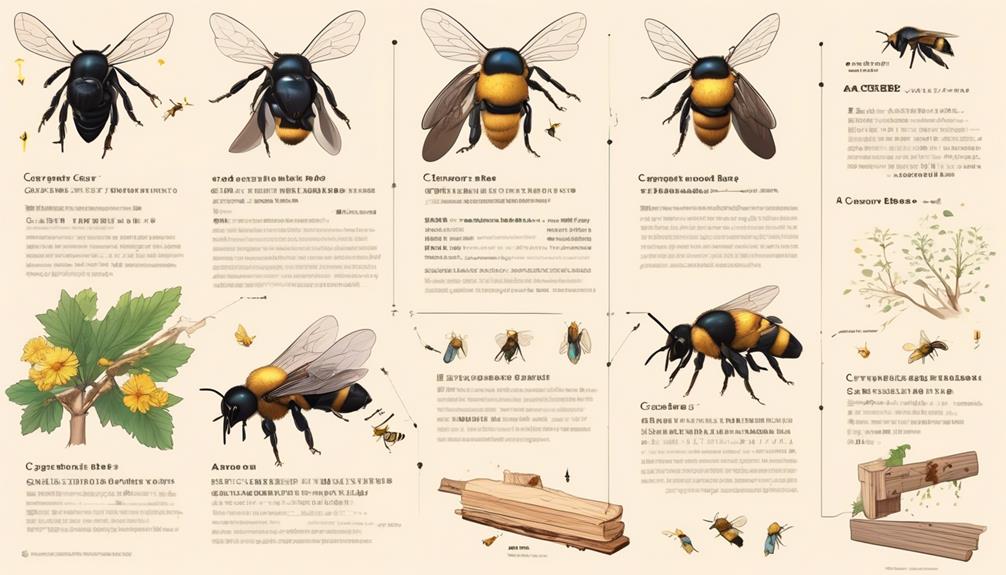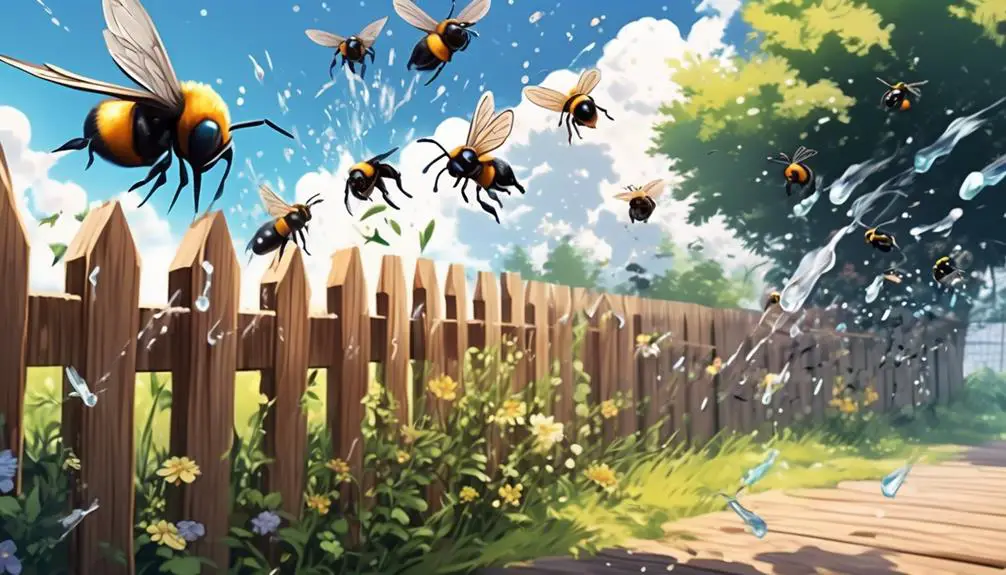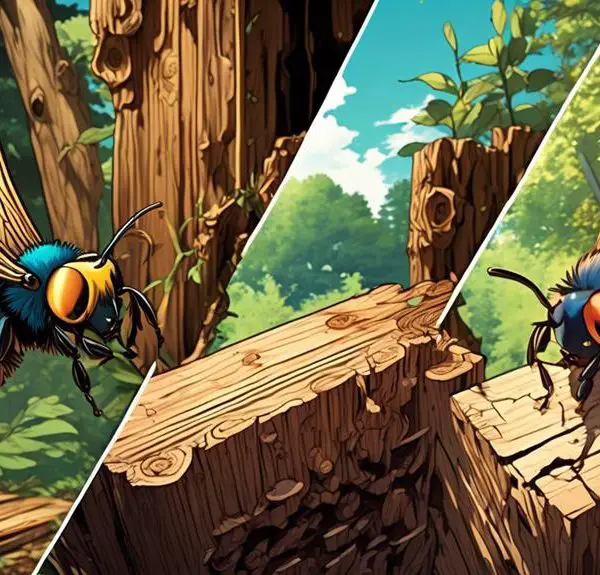Threatened by carpenter bees, your cedar's survival is at stake; discover how to protect its natural beauty and longevity.

Protect Cedar From Carpenter Bees
Is it true that cedar, in all its resilient glory, can indeed fall prey to the unassuming carpenter bee?
You've likely admired the versatility, durability, and elegance of cedar, often used in building materials and furniture.
But lurking within the shadows is a threat to your beloved cedar, the carpenter bee, known for boring into wood to lay their eggs.
While they may not possess the same destructive reputation as termites, don't underestimate the damage they can cause.
To comprehend the severity of the situation, let's explore this further, shall we?
Key Takeaways
- Carpenter bees are solitary creatures that bore holes into wood to lay their eggs.
- They prefer softwood like cedar and are attracted to bare, weathered, or unpainted wood.
- Signs of carpenter bee damage include perfectly round holes on the wood surface.
- To protect cedar from carpenter bees, apply a protective coating, use insecticidal treatments, install traps, and seek professional help for severe infestations.
Understanding Carpenter Bees

To effectively protect your cedar from carpenter bees, you need to first understand these wood-boring insects, their life cycle, and why they're attracted to your cedar in the first place.
Carpenter bees aren't your typical honey-producing bees. They're solitary creatures, meaning each female is fertile and crafts individual nests in wood, rather than living in colonies. The females bore holes into your cedar to lay their eggs, often returning to the same spot year after year, causing significant damage over time.
Their lifecycle is annual, with adults emerging in spring, mating, and then dying in late summer. The new generation then overwinters in the tunnels, emerging the following spring to start the cycle again.
Carpenter bees are attracted to softwood like cedar because it's easier to drill into. They're particularly drawn to wood that's bare, weathered, or unpainted. So, if you've got cedar structures or furniture, they're an inviting target. Understanding this can help you take preventive measures.
Damage Caused by Carpenter Bees

Now that you're familiar with the habits and lifecycle of carpenter bees, let's examine the damage they can inflict on your cedar structures and furniture.
Unlike termites, carpenter bees don't consume wood. Instead, they bore into it to create galleries for their eggs and larvae. This boring can compromise the structural integrity of your cedar items and may even make them unsafe.
The signs of carpenter bee damage are distinctive. You'll notice perfectly round holes, about half an inch in diameter, on the surface of the wood. These holes can be entry points to complex tunnel systems that can extend up to 10 feet within the wood. If you look closely, you might also see coarse, sawdust-like frass around these holes, a byproduct of the bees' excavation.
Over time, the cumulative damage from repeated use of these nests can weaken your cedar structures or furniture. If left unchecked, this damage can result in costly repairs or replacements.
Additionally, the buzzing and hovering of carpenter bees around their nests can be disturbing. So, it's crucial to identify and address carpenter bee infestations early to protect your cedar belongings.
Preventative Measures for Cedar

Implementing certain preventative measures can help safeguard your cedar structures and furniture from carpenter bee infestations. Begin by applying a coat of polyurethane or oil-based paint to the wood. These substances form a protective layer that deters bees from boring into the wood.
Next, consider insecticidal treatments. Products containing cyfluthrin or deltamethrin are particularly effective. Spray this on the exposed wood surfaces in early spring, when carpenter bees are most active. Don't forget to reapply periodically throughout the season for continued protection.
You can also install bee traps around your property. These traps attract carpenter bees and trap them before they can damage your cedar. However, do remember that traps are more of a reactive measure and should be used in conjunction with other preventative techniques.
Lastly, consider professional pest control if infestations persist. Experts come equipped with specialized tools and knowledge to handle severe infestations. They'll also provide recommendations on how to maintain your cedar in the future.
Effective Repellents Against Bees

When it comes to warding off carpenter bees, certain repellents have proven to be quite effective. Your first line of defense should be a quality insecticide. Look for products containing cypermethrin, a synthetic pyrethroid known to deter these pests. Apply it directly to your cedar surfaces, ensuring you've covered all potential nesting spots.
Citrus sprays also work well, as carpenter bees dislike the strong acidic scent. You can create your own by boiling citrus peels in water and transferring the cooled mixture into a spray bottle. Consistently spray this around your cedar structures to keep the bees at bay.
Another notable repellent is Almond oil or essence. The smell is particularly offensive to carpenter bees, making it an excellent deterrent. Simply dab some on a cloth and wipe it onto your cedar surfaces.
Lastly, consider using bee traps. These devices mimic the nests of carpenter bees, attracting them inside where they become trapped and die. They're a non-toxic and environmentally-friendly option.
Repairing Carpenter Bee Damage

If carpenter bees have left their mark on your cedar structures, it's crucial to repair the damage promptly to prevent further deterioration. These insects bore into wood, creating tunnels and chambers where they lay their eggs. This burrowing action weakens the structural integrity of the wood, leading to potential collapse if left untreated.
First, locate the entrance of the bee tunnels, usually a perfectly round hole about half an inch in diameter. You'll often see coarse sawdust, known as frass, around the hole, a telltale sign of carpenter bee activity.
Once you've found the holes, your next step is to kill any bees still inside. A pesticide specifically designed for carpenter bees is most effective. Spray it into the holes, following the manufacturer's instructions.
After 24-48 hours, it's time to repair the holes. Use a wood filler or putty, ensuring it's specifically designed for exterior use. Apply the filler, smoothing it over to match the surrounding area. Once it's dry, sand it down for a uniform appearance.
Conclusion
Understanding carpenter bees and the damage they inflict is crucial.
To protect your cedar, take proactive steps like treating the wood and maintaining a clean environment.
Use effective repellents and consider professional pest control services if necessary.
Don't overlook repairs to any bee damage, as this could lead to further infestation.
With these practical measures, you'll successfully safeguard your cedar from carpenter bees.
It's all about staying vigilant and proactive.



